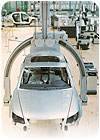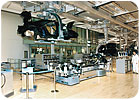
Body
shells are transported between different stations using an automated railway
system. Source: Leica Geosystems
Volkswagen’s glass-enclosed transparent factory in Dresden, Germany, was built specifically to manufacture their premium-segment vehicle, the Phaeton. Volkswagen implemented a production concept combining the automated processes of classic industrial automobile production with manual work processes.
The core element of Volkswagen’s new manufacturing concept is the scaled assembly line. The only thing this operation has in common with conventional assembly lines is the phasing of individual assembly procedures such as engine fitting and window fitting. Concentrically designed scaled assembly lines are made up of 29 individual segments with wall-to-wall hardwood floors. On these segments, vehicles to be assembled are set in place by lifters with many setting options. The entire setup looks more like a high-tech trade workshop than an assembly-line operation because of the hardwood floors and the organized assembly parts placed in baskets.

Different
modules, such as entire cockpits as one unit, are being installed into the
Volkswagen Phaeton. In this vehicle class, the level of individual interior
amenities can vary substantially from vehicle to vehicle, and all the parts
required for a particular vehicle are brought for assembly in robotic mobile
trolleys. Source: Leica Geosystems
Volkswagen has achieved a high level of manufacturing quality at its Dresden site with its precision-phasing system, the cleanliness of production areas, a trained workforce and permanent controls. The individually phased production processes have been systematically tailored to the people who perform them. For example, the manipulator is an assistant on navigable rollers enabling workers to adjust the positioning of large components, such as whole dashboards, to the last millimeter required for their installation into the body shell.
The transparent factory is a glass tower nearly 40 meters in height where automobiles are displayed as they wait for their new owners to pick them up. Customers who order a Volkswagen Phaeton can actually watch their own vehicle being made. This dedication to excellence manifests itself in many ways-from the attention paid to the width of the gap between individual sheet metal segments, to the way headlamp elements seamlessly hug the fender, to the thump a door makes when it shuts.

The
location of the ABS control module is just one of the engine subgroups whose
location is checked against target values. The operator can follow the progress
of the measurement and any possible deviations in real time on the application
PC running the Metrolog XG for Leica software. Source: Leica Geosystems
Quality Unfolds
The metrology department at the Dresden plant, under the guidance of Frank Herold, is in charge of ensuring the perfect fit. The department calibrates and sets the production tools, and conducts the initial inspection of the subassembly and body shells. In addition, they perform analysis measurements to determine how various external parts fit to one another. In short, the metrology department keeps all these different processes stable and well within tolerances.These measurements are extremely important in a vehicle in the premium class because buyers expect nothing but impeccable attention to detail. In the past, the department relied on a large-scale measurement facility with conventional coordinate measurement machines (CMMs). This facility was not located on the premises, which meant transporting half-finished vehicles offsite and back to the transparent factory. This production interruption involved time loss and added costs.
When Herold started looking for an alternative solution, he realized any replacement solution had to be cost-effective and provide substantial benefits. He explains, “We wanted to implement a versatile measurement system that would allow us to cut the time needed to inspect a finished vehicle. Of course, the system had to meet our strict accuracy, stability and quality requirements. Together with our partners in the planning department, we decided to shift the responsibility for calibrating and setting entirely to the assembly group, with the requirement to discontinue using setting masters normally used for such tasks and focus solely on laser trackers.”
Thanks to their migration to two Leica (St. Gallen, Switzerland) T-Probe systems, Volkswagen was able to cut the time needed to inspect a vehicle by at least four to five hours. Plus, they eliminated the entire time and effort normally invested in the maintenance and alignment of the setting masters as well as the whole storage space.
“What we have effectively done is cut the end inspection times in half,” Herold says. “Having a fixed CMM installation on the premises was out of the question for us due to our spatial constrictions. Rather than bringing the finished car to the CMM, we are now bringing the CMM to the car instead.”

Inspecting
the position of hard-to-reach parts is a non-issue. The fact that the reference
point on the exhaust system located on the underbody is hidden from sight is
irrelevant. As long as the Leica T-Probe maintains a line of sight to the Leica
Laser Tracker, accurate measurements can be made. Source: Leica Geosystems
Innovative Doublet Approach
Volkswagen acquired two complete wireless Leica T-Probe systems that both measure in the same coordinate system. One system inspects the front end and the left side of the car. The second system inspects the car’s rear and the right-hand side. This combination saves a tremendous amount of time.Volkswagen cut the inspection times from a day’s worth of work down to three to four hours, effectively halving the inspection times. This time span of three to four hours is achieved with two laser trackers in a doublet configuration.
Using a tracker double rather than a single tracker saves another two hours. If a single tracker was used, it would have taken an extra two hours because of repositioning and realignment and the fact that only one operator can work at any one time instead of two. With two trackers, they can gather data with two trackers in parallel.
Leica distributor Aicon 3D Systems (Braunschweig, Germany) brought this idea to life. Aicon’s Thomas Nickel explains, “We’ve created a laser tracker Doublet. Because both systems are controlled by the Metrolog XG for Leica software and use the same coordinate system, data sets can be simply exchanged between the two. This way, the laser tracker duo can fully replace a mobile double-column CMM. This double laser tracker setup gives the operator easy access to all sides of the vehicle without the need to reposition the laser tracker. Our system is totally mobile and the inspection of hard-to-reach positions, such as the car underbody, is a breeze. This solution is one-of-a-kind.”
The two Leica T-Probe systems are not just used in the metrology lab, but throughout the transparent factory. In addition to inspecting panel gaps on finished vehicles, they conduct the initial inspection on different modules and subassemblies-such as the entire cockpit as one unit. For example, the portable CMM system is used to inspect the stationary tools on axis alignment, which now takes only 45 minutes.
Herold concludes, “In the future, we plan to introduce laser scanning of surfaces, which will make the measurement processes even more time-efficient, and the Leica T-Scan is the logical choice here because it would seamlessly integrate into our existing laser tracker-based portable CMM system and has the same large measurement volume of 30 meters. Thanks to our dual Leica T-Probe system, we have effectively halved inspection times on finished vehicles and have at the same time gained an unsurpassed level of versatility, being able to loan out a complete system to other departments, completing two very different sets of tasks with just one solution: both end inspection of finished vehicles and tool inspection in the assembly line.”
Leica Geosystems, a Hexagon Co.
+ 41 71 727 3131
www.leica-geosystems.com
Benefits
- By
using two Leica T-Probe systems, Volkswagen was able to cut the time needed to
inspect a vehicle by at least four to five hours.
- Volkswagen also eliminated
the time and effort normally invested in the maintenance and alignment of the
setting masters as well as the whole storage space.
- Space did not allow for a fixed CMM installation, so rather than bringing the finished car to the CMM, Volkswagen now brings the CMM to the car instead.